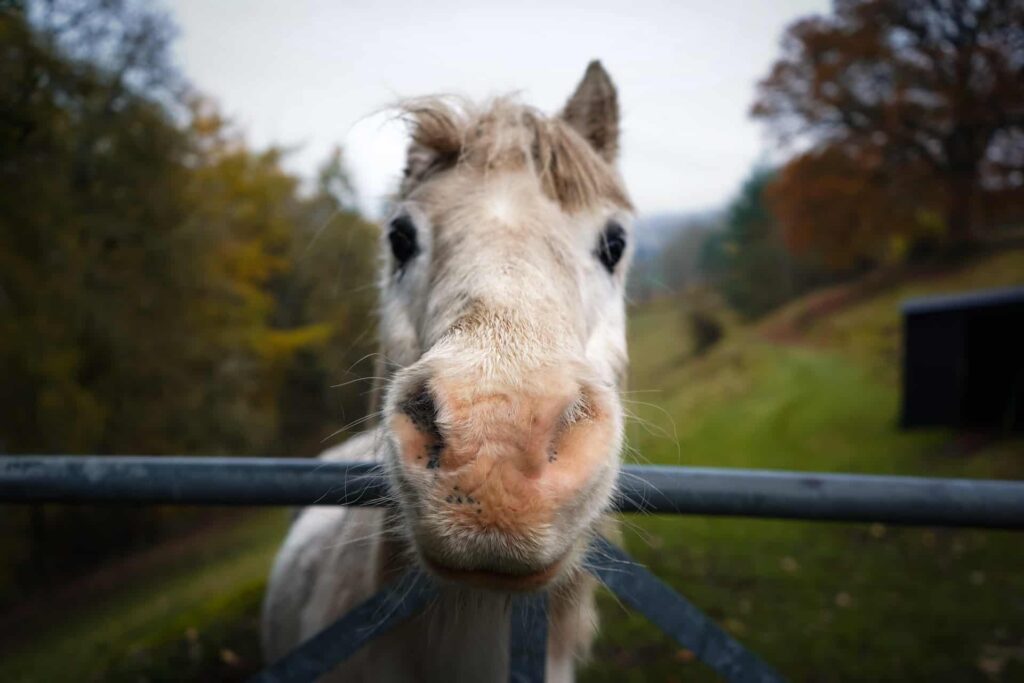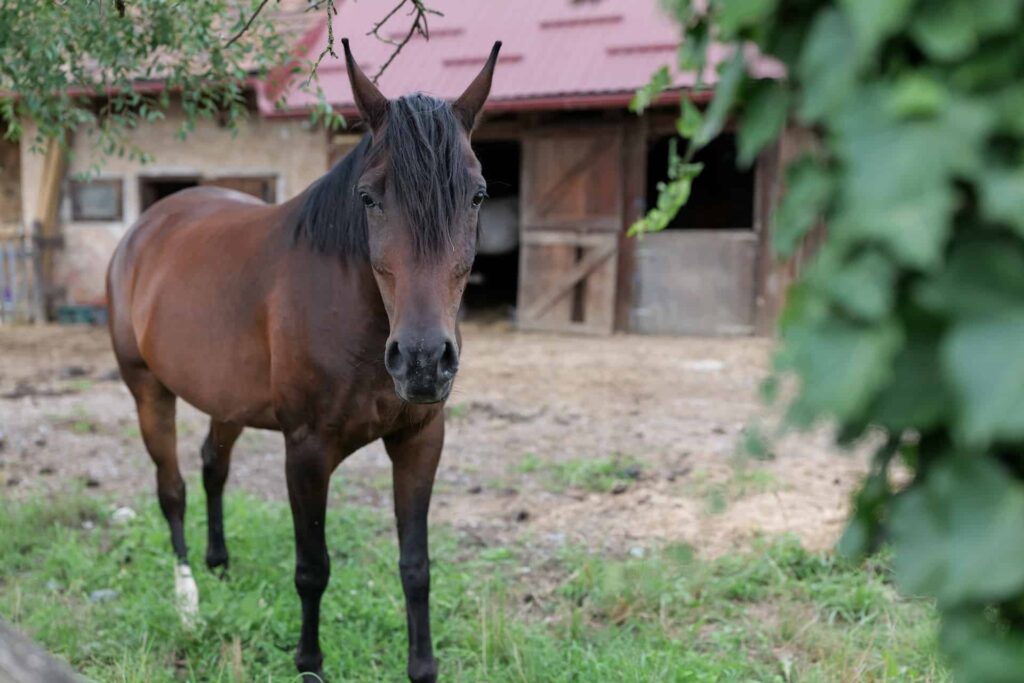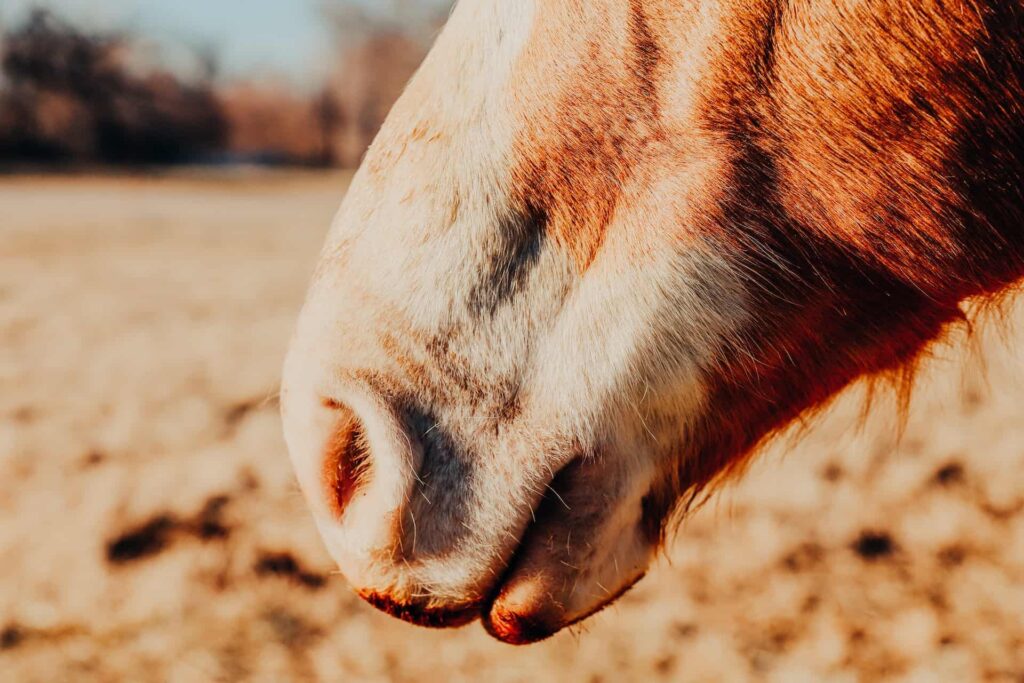A horse nose bleed, also known as epistaxis, can be concerning for horse owners and riders. Although most nosebleeds are minor and resolve on their own, some cases require immediate attention from a veterinarian. Epistaxis in horses can be caused by various factors, such as trauma, injuries to the nasal passages, or underlying health issues.
Understanding the causes, appropriate diagnosis, and treatments for horse nosebleeds is essential for maintaining the overall health and well-being of these animals. Early intervention can prove crucial in mitigating prolonged bleeding, and complications, and ensuring a smooth recovery process. Proper management and awareness of nosebleeds in horses are vital in addressing potential issues and preventing more severe health concerns.
Key Takeaways
- Horse nosebleeds, or epistaxis, can result from various causes and may require veterinary attention.
- Proper diagnosis and treatment are vital for maintaining a horse’s well-being and preventing complications.
- Awareness and management of horse nosebleeds play a crucial role in addressing potential issues and ensuring a smoother recovery process.
Understanding Horse Nose Bleeds
Horse nosebleeds, also known as equine epistaxis, occur when blood vessels in the nasal passages, throat, lower airways, or lungs are injured to a degree where they begin leaking blood. It can be a startling sight for horse owners, but it’s essential to approach the situation with a knowledgeable and clear understanding of the condition and its possible causes.
Blood may be observed in one or both nostrils, which indicates a unilateral or bilateral nosebleed, and various factors may contribute to the occurrence of nosebleeds in horses. The blood may be mixed with nasal discharge, which can be odorless or have an odor. In some cases, the discharge may be mucopurulent and viscous.
There are different reasons for a horse to experience a nosebleed. Common causes include trauma to the head or nostrils, infection, foreign bodies, and bleeding disorders. Moreover, the severity of the nosebleed can range from mild to life-threatening, depending on the underlying cause. Some nosebleeds subside within 20 minutes with no lasting effects, but others may require immediate veterinary attention.
It’s crucial to monitor the horse’s behavior during a nosebleed. Symptoms such as frequent snorting, persistent head shaking, rubbing or scratching the nose against surfaces, and labored breathing can provide valuable clues to the nature of the issue. These signs may hint at blood accumulation within the respiratory system, which can interfere with normal air exchange and should be assessed by a veterinarian.
Equine nosebleeds can often be managed and treated effectively when their cause is promptly identified. However, it’s essential to maintain a confident yet neutral approach and consult a veterinarian for an accurate diagnosis, as well as to discuss appropriate treatment and recovery measures for the horse’s specific case.
Causes of Nose Bleeds in Horses
Trauma
Trauma is one of the most common causes of nosebleeds in horses. Head injuries, facial bone, or skull-base fractures can result from kicks, accidents while being transported, or when a horse falls and hits its head. This type of injury is more common in young, non-athletic horses.
Exercise-Induced Pulmonary Hemorrhage (EIPH)
EIPH occurs when blood vessels in the horse’s lungs rupture during strenuous exercise, causing blood to fill the airways and sometimes escape through the nostrils. This condition can affect the horse’s exercise tolerance and overall respiratory health.
Guttural Pouch Mycosis
Guttural pouch mycosis is a fungal infection affecting the guttural pouches, which are air-filled sacs connected to the horse’s respiratory system. The fungus may erode blood vessels, causing bleeding into the pouches and eventually leading to nosebleeds.
Ethmoid Hematomas
Also known as progressive ethmoid hematoma, this condition involves the formation of a blood-filled mass on the ethmoid turbinate, a delicate bone structure within the horse’s nasal cavity. Ethmoid hematomas may cause blood to seep into the airways, resulting in nosebleeds.
Sinusitis
Inflammation of the paranasal sinuses can cause sinusitis in horses, which may lead to nosebleeds. The condition may be triggered by infection, allergies, or foreign bodies lodged in the nasal cavity.
Foreign Bodies
Foreign objects, such as plant material or small stones, can become lodged in a horse’s nasal cavity, resulting in irritation and possible trauma. This can provoke a nosebleed as a response to the irritation.
Infections
Bacterial infections, such as streptococcus pneumonia, can lead to nosebleeds in horses. These infections may affect the respiratory system and cause inflammation and irritation in the airways and nasal passages.
Neoplasia
Tumors and other abnormal growths in the horse’s respiratory system, sinuses, or nasal cavity can also be a cause of nosebleeds. Malignant tumors can erode blood vessels, increase pressure on the surrounding tissues, and lead to bleeding.
Surgery-Related Complications
Post-surgical complications, such as infection, inflammation, or damage to nerves and blood vessels, can cause nosebleeds in horses. It is essential to monitor horses closely after surgery to ensure proper healing and avoid complications.
Diagnosis and Tests
Physical Examination
A veterinarian or equine specialist will begin the diagnostic process with a thorough physical examination of the horse. During the physical exam, the veterinarian will look for any signs of weakness, pale gums, and irregular heart rate. They will also pay close attention to the color and consistency of the blood, as well as the location from which the bleeding is occurring. This initial examination will help determine if the nosebleed is self-limiting or requires further investigation.
Endoscopy
Following the physical examination, endoscopy is an essential diagnostic tool for determining the underlying cause of a horse’s nosebleed. An endoscopic exam involves inserting a flexible endoscope into the horse’s nasal passages, allowing the specialist to visualize the source of bleeding and evaluate the integrity of the blood vessels.
Endoscopy can help identify any abnormalities within the nasal cavity or assess damage to the mucosal surfaces. A pediatric endoscope may be utilized for a more thorough examination of the narrower areas in the nasal passages.
Radiography
Radiography or X-rays may be necessary to further diagnose a horse’s nosebleed, especially if the bleeding is persistent or recurrent. Radiographs can provide detailed images of the horse’s skull and upper respiratory tract, which can help identify any structural abnormalities, injuries, or the presence of foreign bodies causing the bleeding. It’s important for the horse to be properly sedated and positioned during the radiography process to obtain clear and accurate images.
Magnetic Resonance Imaging
Magnetic Resonance Imaging (MRI) is a more advanced diagnostic tool that may be used in certain cases when the cause of the nosebleed remains unclear, despite previous examinations and tests. MRI provides high-resolution images of the horse’s head, including soft tissues and blood vessels, allowing for a more comprehensive evaluation of the nasal cavity and surrounding structures.
Due to its higher cost and limited availability, MRI is typically reserved for cases where other diagnostic methods have not provided conclusive results, and the horse may need to be referred to a specialized equine hospital for this procedure.
Treatment Options and Management
Rest and Observations
One of the first steps in managing a horse with a nosebleed is to allow the animal to rest and closely observe its condition. Horses should be kept calm and their breathing monitored during this time. This helps prevent any further exacerbation of the condition and can allow blood vessels to constrict, stopping the bleeding.
Antibiotic Therapy
In some cases, a horse with a nosebleed may require antibiotic therapy to address any potential infections contributing to the issue. A veterinarian will determine if this is necessary based on the horse’s overall health, the severity of the nosebleed, and any underlying conditions that may be present.
Surgical Interventions
If other treatment methods prove to be unsuccessful or if a horse has a severe case of nosebleeds, surgical interventions may be necessary. One option is the use of laser treatment to close off damaged blood vessels. Another possibility is formalin injection, which can help seal off the bleeding vessels by causing them to contract.
Treating Underlying Conditions
It is essential to identify and treat any underlying conditions contributing to the nosebleed. This can involve a thorough examination by a veterinarian and diagnostic tests to determine if there are issues such as respiratory infections, head trauma, or foreign matter within the horse’s nostrils. Addressing these causes is crucial in effectively managing and preventing future nosebleeds.
Medical Management
Medical management is a key aspect of treating horse nosebleeds. This can include the use of medications to help control bleeding, promote clotting, and reduce inflammation. Veterinary medicine can play a crucial role in addressing the immediate symptoms of a nosebleed and ensuring the horse is on the path to recovery.
Prognosis and Recovery
Prognosis and recovery for horse nosebleeds, or epistaxis, largely depend on the underlying cause and the severity of the bleeding. In most cases, nosebleeds are not serious and subside within 20 minutes, leaving no lasting effects on the horse. However, it’s important to consult with an equine veterinarian to determine the specific cause and ensure proper treatment.
For nosebleeds caused by minor trauma or environmental factors, such as dryness in the nasal passages, recovery is typically rapid and straightforward. The horse may require some rest and medication to alleviate discomfort or prevent infections.
When the nosebleed is a result of more severe trauma, such as facial bone or skull-base fractures, the recovery process can be more complicated. These cases might necessitate surgery or other medical interventions to address the injury. As long as the horse receives adequate veterinary care and follows prescribed treatment plans, the prognosis is generally positive and the horse’s chances of recovering fully are high.
If the nosebleed is caused by a more serious underlying condition, such as a tumor or a systemic illness, the prognosis may be less favorable. Treatment in these cases often involves addressing the primary condition, and the horse’s recovery will depend on how well the condition is managed. It is crucial to closely monitor the horse’s progress and follow the veterinarian’s advice to give them the best chance of full recovery.
While the prognosis for most horse nosebleeds is positive, identifying and addressing the specific cause of the bleeding is essential for optimal recovery. Seek professional veterinary guidance as soon as possible, as early detection and treatment can greatly improve the horse’s chances of a full recovery.
Final Thoughts
In cases of horse nosebleeds, also known as epistaxis, it is essential to evaluate the severity of the situation and the potential underlying causes. Blood loss in the form of a nosebleed might not always be severe, but it could be an indication of an issue within the horse’s respiratory tract or other related anatomical structures.
Mucus mixed with blood may be present in some cases of epistaxis. This could indicate the blood is coming from the upper respiratory tract or nasal passages. In such instances, it is essential to investigate further and determine the origin of the bleeding.
During the diagnostic process, a veterinarian may perform a lavage, which involves flushing saline through the nasal cavity to evaluate the blood and mucus present more accurately. This procedure can provide valuable information about the source of bleeding and help guide the appropriate course of action.
One potential source of bleeding might be a tooth root abscess, especially if the blood is predominantly coming from one nostril. In this case, a dental examination should be conducted, and appropriate treatment measures taken to resolve the issue.
In some instances, the nosebleed may be a result of benign causes such as minor trauma to the nasal passage. Regardless, it is crucial to have a veterinarian assess the situation to ensure that there is no underlying issue that might lead to more serious complications.
In conclusion, it is vital to approach horse nosebleeds with a knowledgeable and confident attitude, ensuring that the appropriate diagnostic measures take place to determine the cause of the bleed and ultimately provide the best care possible for the horse.
Related: Horse Health
Frequently Asked Questions
What causes nosebleeds in horses after a race?
Nosebleeds in horses after a race are often due to the exertion and increased blood pressure that occurs during intense exercise. One of the main causes is exercise-induced pulmonary hemorrhage (EIPH), where blood vessels in the lungs break and blood enters the respiratory tract.
How can allergies lead to a horse’s nosebleed?
Allergies can cause inflammation in a horse’s respiratory system, leading to nosebleeds. Irritants such as dust, pollen, or mold can cause an allergic reaction, resulting in nasal congestion and increased pressure on the blood vessel source.
Do temperature changes affect nosebleeds in horses?
Temperature changes, particularly extreme cold, can lead to nosebleeds in horses. Cold temperatures can cause blood vessels in the nasal passages to constrict and then dilate rapidly, making them more susceptible to breakage.
How to treat a horse with a nosebleed?
If a horse is experiencing a nosebleed, keep it calm and allow it to rest with its head slightly elevated. This position will help minimize blood flow to the affected area. In most cases, nosebleeds will subside on their own within 20 minutes. If the bleeding persists or is severe, consult a veterinarian immediately.
What factors lead to nosebleeds in older horses?
Older horses may experience nosebleeds due to age-related factors, such as weakened blood vessels, and dental issues that can lead to infections or tumors in the respiratory tract. Additionally, older horses may have a higher risk of trauma to the head or nasal area.
Can a horse experience nosebleeds in both nostrils?
In most cases, a horse will experience a nosebleed from one nostril. However, if the bleeding is severe or originates from the lungs, it is possible for blood to flow from both nostrils. Always consult a veterinarian if your horse experiences nosebleeds in both nostrils, as this could indicate a more serious underlying condition.
Last Updated on September 28, 2023 by Nate Dewsbury



